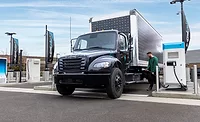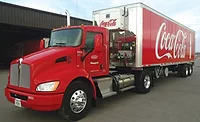2023 Trucks Report: Electric vehicles continue to make most of the news in the fleet equipment space
Trucks manufacturers equip vehicles with latest software, improved ergonomics
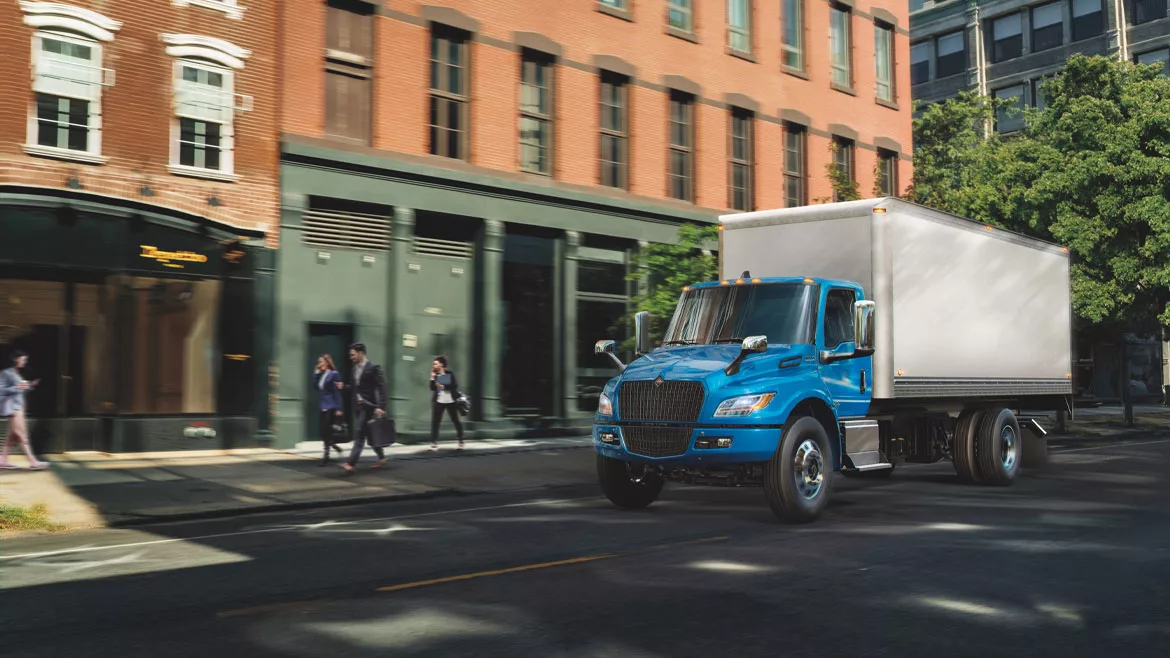
Image courtesy of Navistar International Corp.
This year’s crop of new vehicles and enhancements from the world’s top original equipment manufacturers (OEMs) and their partners offers a little something for just about everyone. As has been the case in past years, there certainly is no shortage of battery-electric and electric fuel cell vehicles, as such solutions continue to roll out in earnest. But there’s also quite a bit of innovation happening in more traditionally fueled vehicles like diesel- and gasoline-powered trucks. Natural gas also makes a bit of a comeback this year with some new engine announcements.
And cutting edge safety and telematics technologies that just a few years ago weren’t necessarily in every fleet operators’ budgets are starting to become standard on a number of vehicle options, from the lightest duty cargo vans all the way up to Class 8 trucks. As we roll into 2023, expect to see all of these trends accelerate, especially as in-person attendance at major trucking expos is back to normal levels and OEMs will be eager to showcase some of their most significant equipment creations and upgrades to date. Here’s a glimpse at what’s to come as we kick off the new year.
Navistar/International
Navistar has standardized a factory-installed telematics device on all new builds of its Class 6 to 8 International trucks. The factory-installed telematics device broadcasts data to OnCommand Connection, Navistar’s connected services platform, which aggregates vehicle health and performance data and turns that into actionable information.
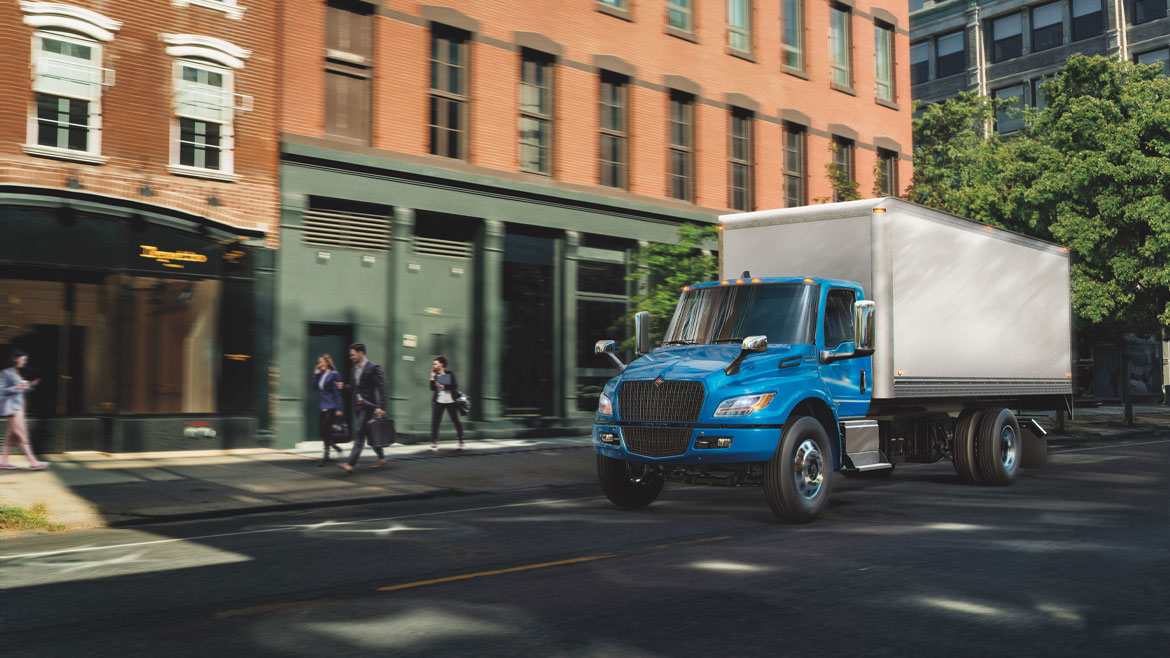
OnCommand Connection has more than 30 telematics partner integrations that allow for the platform’s unique open architecture to integrate with all makes and models of vehicles on the market. The standard OnCommand Connection service package provides customers access to the following:
- Over-the-air programming vehicle software updates for approved engine calibrations and performance parameter updates to improve customer uptime by keeping vehicles on the road
- Vehicle health monitoring that can help identify issues and allow customers to take the appropriate action
- GPS and geofencing functionality that allows for asset tracking and protection
- Access to the International 360 service communications platform that streamlines the service scheduling process and allows customers to customize routine maintenance intervals based on vehicle usage.
Earlier this year, Navistar opened Michigan’s first public electric vehicle charging station at its Kalamazoo location, located directly off of I-94, which is one of the largest freight corridors in the Midwest. The new EV charging station is optimized for commercial vehicle charging and will provide fleets the ability to charge larger vehicles, including Class 8 electric trucks. The DC fast charger features two 24-hour charging hookups.
Navistar’s eMV Series batter-electric medium duty trucks have been in full production since the summer of 2021.
Daimler Truck North America/Freightliner
Daimler in September unveiled its new Plus series, enhanced versions of its M2 models including the M2 106 Plus and M2 112 Plus. The enhanced models provide a major update to the interior and electrical systems of the popular M2 and SD models.
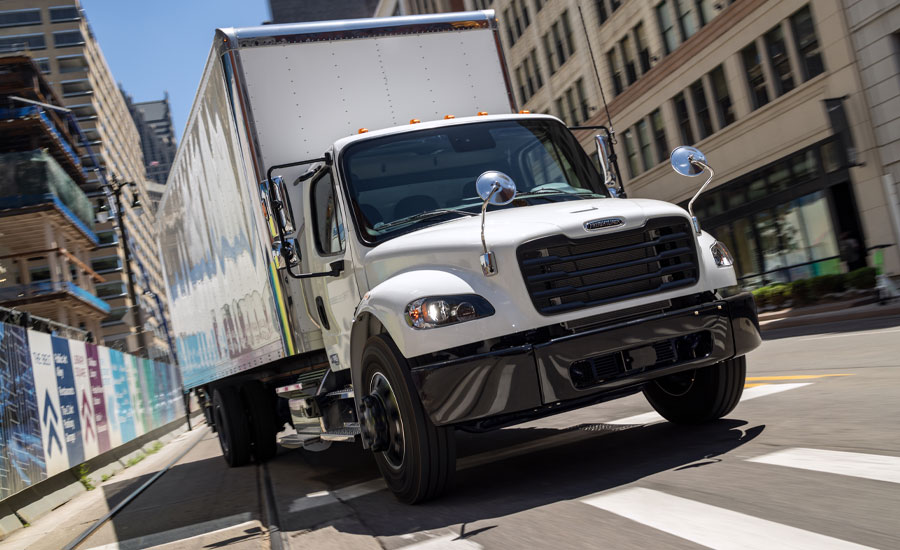
The Plus series is designed to take Freightliner’s medium-duty lineup to the next level with improved driver comfort and increased productivity potential, the company says. The Plus series trucks now feature an all-new interior designed for a more comfortable, safer driving experience with improved ergonomics and increased storage. The following are enhancements with the Plus series:
- All-new trim levels designed for customer preference and applications; improved insulation that muffles exterior noise and provides greater thermal efficiency.
- Driver-centric dash with an easy-to-read driver information center.
- A fully customizable switch layout.
- Comfortable steering wheel with integrated controls.
- An easy-to-use transmission control stalk that allows automated manual and automatic shifting and engine braking functions from the column for safer operation.
- Configurable dash panel featuring 2.5-times more space for truck equipment manufacturers to utilize.
- Ergonomic seats with precise adjustability for improved driver comfort and reduced fatigue.
Operators have access to a comprehensive suite of safety and connectivity, available across entire medium-duty truck lineup. With its new electrical architecture, the Plus series trucks give customers access to the industry-leading Detroit Assurance with ABA5 suite of safety systems. In addition to being available with all Detroit engine models, customers will for the first time be able to order certain Detroit Assurance features when spec’ing a Cummins engine. Standard selected safety features including Active Brake Assist, Lane Departure Warning, and optional Side Guard Assist allow for increased safety on the road or jobsite. Additional features like Adaptive Cruise Control, which automatically adjusts cruising speed to maintain a safe following distance, will become available with the Plus series start of production in the 2023 third quarter.
PACCAR/Kenworth/Peterbilt
Kenworth announced this year that it is offering the Cummins B6.7 natural gas engine on its new medium-duty T180, T280 and T380 trucks in the United States. The 100% natural gas engine features spark-ignited combustion with cooled exhaust gas recirculation (EGR) and a maintenance-free three-way catalyst.
It also sports a closed crankface ventilation system and on-board diagnostics for optimal emissions performance, the company says. The low-emissions engine is certified to the California Air Resource Board’s optional low NOx standard, which is 90% lower than the current EPA standard. It can be used with either a compressed natural gas (CNG) or liquefied natural gas (LNG) fuel system. Kenworth’s Class 5 T180, Class 6 T280 and Class 7 T380 are designed for optimal maneuverability and visibility and boast driver-focused ergonomics and a spacious, 2.1-meter-wide cab.
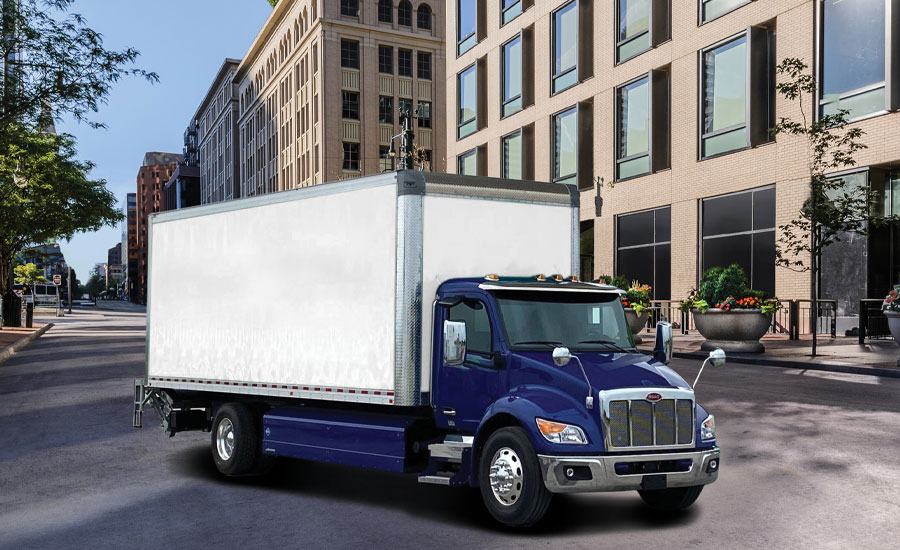
PACCAR’s Peterbilt Motors Co. also announced that the B.67 natural gas engine will be available on its medium-duty 536 and 537 models.
The Class 6, non-CDL Model 536 was designed to provide drivers optimal performance with a low cab entry height, ideal visibility, low NVH (noise, vibration and harshness) and room for three people within the 2.1-meter wide cab. Critical information is relayed to drivers through a 7-inch digital display located in the instrument cluster and featuring an intuitive digital card system fully integrated with the latest Peterbilt safety systems.
Kenworth also introduced its Online Medium Duty Body Builder Manual, a comprehensive, 152-page manual focusing on its conventional vehicle lineup, ranging from Class 5 to light Class 8 models. The manual offers 10 detailed sections featuring an Introduction, Safety and Compliance, Dimensions, Body Mounting, Frame Modifications, CAN Communications, Electrical, Power Take-Off (PTO), Aftertreatment and Routing. It contains information and guidelines useful in the truck body planning and installation processes. Also offered are listings with name and page number for both the manual’s 30 tables and 127 figures for quick, easy reference. The company says the manual is especially helpful when spec’ing a new medium-duty truck, particularly when the body-builder is involved in the vehicle definition and ordering process.
Finally, the company announced that its new Class 8 T680, T880 and W990 now are available for order with the optional Kenworth Lane Keeping Assist, which uses camera input to identify when the truck is departing the lane and “nudges” the driver to help keep the truck centered in the lane. It requires the truck to be factory-equipped with the Bendix Fusion advanced driver assistance system.
Mercedes-Benz Vans
Mercedes-Benz has made further improvements to its Sustaineer all-electric van based on its eSprinter, which, the company says, are designed to improve the quality of life in cities, conserve resources, and improve the health and concentration of the driver.
These include new close-range heating elements, automatic radiator shutters, the mobilization seat and the Driver Coaching App. Features already familiar from the predecessor ― such as fine dust filters on the front module and underbody, a solar panel on the roof and components made from recycled materials ― can still be found on board the technology platform. The innovations and technical solutions fitted in the Sustaineer have been designed with the possibility of series production in mind, so that their use in future vehicle generations from Mercedes-Benz Vans is feasible.
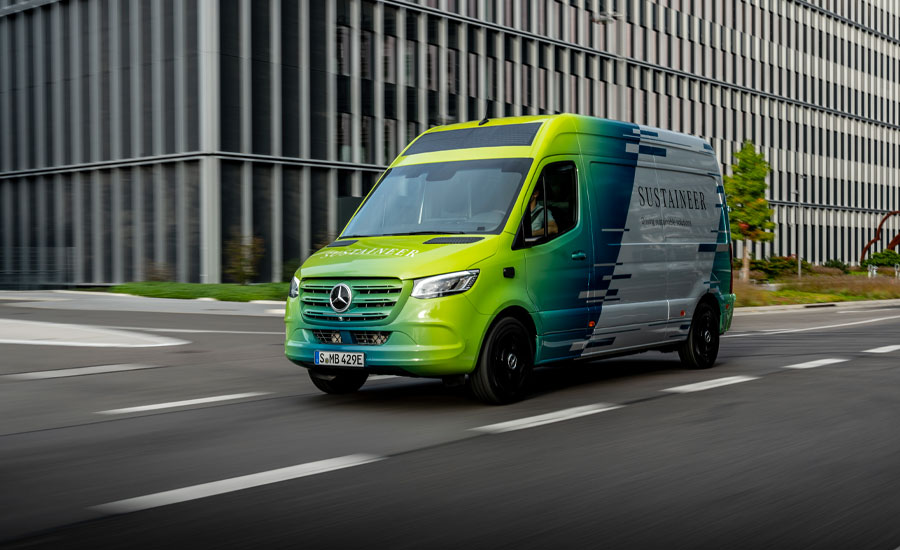
Because of the high heating energy demand caused by the large driver’s cab and the constant opening and closing of the doors during delivery stops, conventional vehicle heating systems have a noticeable effect on the range of electric vans. The Sustaineer improves on this by putting the warmth exactly where it is needed — the driver’s body. In addition, other efficient thermal management measures have been implemented that can further increase the range of a battery-electric van like the eSprinter, a major benefit for courier, express and parcel services (CEP sector), it says.
In addition to the seat, the steering wheel and the seat belt, surfaces on the driver’s door, in the footwell and on the steering column trim also can be heated electrically. The close-range surface heating elements consist of an electrically conductive silver-carbon coating printed on a fleece. By virtue of their high surface temperatures, thermal comfort is ensured by radiant heat close to the body, thus significantly improving the thermal efficiency of the heating system. Another advantage ― in contrast to the usual heating of vehicle interiors in winter where the interiors cool down relatively quickly during unloading processes ― is the surfaces will stay warm.
The mobilization seat, meanwhile, is designed to improve and maintain the driver’s performance for longer. Long periods spent sitting down can increasingly adversely impact health, ranging from back pain to psychological impairments such as fatigue and a reduction in cognitive abilities. Changing the seating position could help combat those effects, the company says. With the mobilization seat, Mercedes-Benz Vans has transferred this principle to the driver’s seat in the van, it notes. Air chambers are integrated into the seat surface and backrest of the mobilization seat in the Sustaineer. These are specifically inflated and deflated to induce movement and rotation in the driver’s body, it says. Different sequences that imitate asymmetrical or symmetrical walking and tilting of the pelvis activate different areas of the air chambers and thus form the basis for a varied mobilization program.
Next, the Driver Coaching App helps drivers to optimize their driving behavior.
In everyday operations, this tailor-made solution for van fleets acts as an “intelligent co-driver” and aims to give drivers specific assistance in optimizing their driving behavior. The goals include a significant improvement in operating range as well as the conservation of resources. In addition to specific feedback on individual driving behavior, the program includes training and gamification approaches that motivate more efficient driving.
Ford Transit
Also on the light-duty van commercial van front is the 2023 Ford Transit Cargo Van, which features pre-collision assist with automatic emergency braking, which scans the road ahead and can alert the driver about potential collisions with vehicles or pedestrians detected in their path. If needed, it will then automatically apply the brakes — only when necessary. The 2023 Ford Transit also comes equipped with Ford Pro Telematics, which lets the fleet manager monitor the vehicle to understand where it goes, how it’s used and how it’s running. Modems come standard in new vehicles, or an available plug-in device can connect the entire fleet if they’re not Ford trucks. Standard in all Ford Transit vans is electric power-assisted steering, which monitors and adapts to road conditions to make turning the wheel easier.
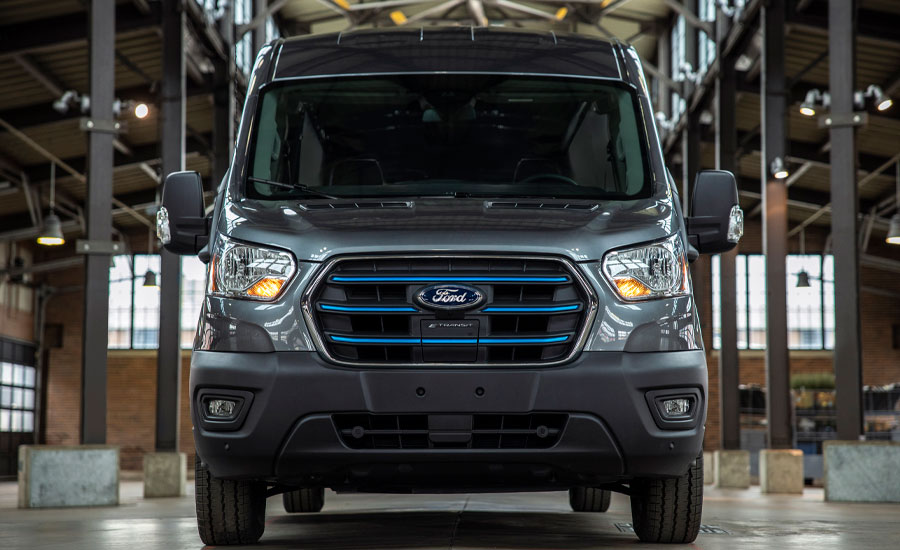
Also standard on the 2023 Ford Transit are exterior features such as a fender-mounted audio antenna, carbon black body side moldings, 50.50 hinged rear door with 180-degree opening, sliding passenger-side door, front license-plate bracket and auto high-beam headlamps. Interior features include standard air conditioning, passenger-side airbag cutoff switch, medium center console, post-collision braking, lane keeping system, manual reclining driver and front-passenger bucket seats with adjustable headrests, and vinyl floor covering.
Isuzu, Hino & Toyota
Isuzu Motors Ltd., Toyota Motors Corp., Hino Motors Ltd. and Commercial Japan Partnership Technologies Corp. (CJPT) announced that they would jointly plan and develop light-duty fuel cell electric trucks for the mass market.
In addition to often being equipped with refrigeration and freezing functions, light-duty vehicles are regularly required to drive long distances over extended hours to perform multiple delivery operations in one day. They must also meet requirements such as fast refueling capability. The use of fuel cell technology, which runs on high energy density hydrogen and has zero CO2 emissions while driving, is considered effective under such operating conditions, the companies state.
CJPT will be responsible for planning the jointly developed mass-market light-duty FC electric trucks. The four companies will apply their combined knowledge — the truck technology that Isuzu and Hino have accumulated over the years as well as Toyota’s fuel cell technology — in pursuit of products that meet the performance and conditions required for light-duty trucks.
In other news closer to home, Isuzu Commercial Truck of America Inc., announced the start of production for its 2023 N-Series gasoline and diesel-powered trucks.
The gasoline-powered N-Series Class 3 and 4 models are getting many of the enhancements that were introduced on the 2022i N-Series diesel trucks. Among those is four-wheel disc brakes, as standard rear disc brakes are joining the already standard front disc brakes, replacing the previous rear drums on the model year 2023 NPR and NPR-HD gasoline models. The NPR will feature 11.5-inch discs front and rear, while the NPR-HD will have 14.3 discs in the front and 13.7-inch discs in the rear.
Additionally, cabs of all 2023 N-Series gasoline models are getting an exterior cab refresh, including a standard matte-silver grill — replacing the white grill of past model years — redesigned turn signals and bi-LED headlamps with signature light that deliver more light and less heat than halogen bulbs; and enhancements to the interior color schemes, featuring darker gray colors on the lower section, along with darker accents on key driver touchpoints. Above, lighter gray components will foster a greater sense of spaciousness. And the seat surfaces are now covered in a gray-and-blue cross-pattern tricot fabric.
On the N-Series diesel models, the company added a significant feature to the factory-installed Isuzu Advance Driver Assistance System (ADAS). The optional package now includes adaptive cruise control (ACC), which enables the driver to set both a desired speed and desired following distance from the vehicle ahead.
Volvo Trucks North America
The big news from Volvo is its I-Torque powertrain innovation, now is available as an option with the latest D13 Compound engine.
The all new Volvo I-Torque enables the truck to operate optimally with up to a 31% increase in fuel efficient speed range, achieving as much as an 8.5 miles per gallon at 85 mph (though Volvo urges all drivers to observe whatever the posted local speed limit is).
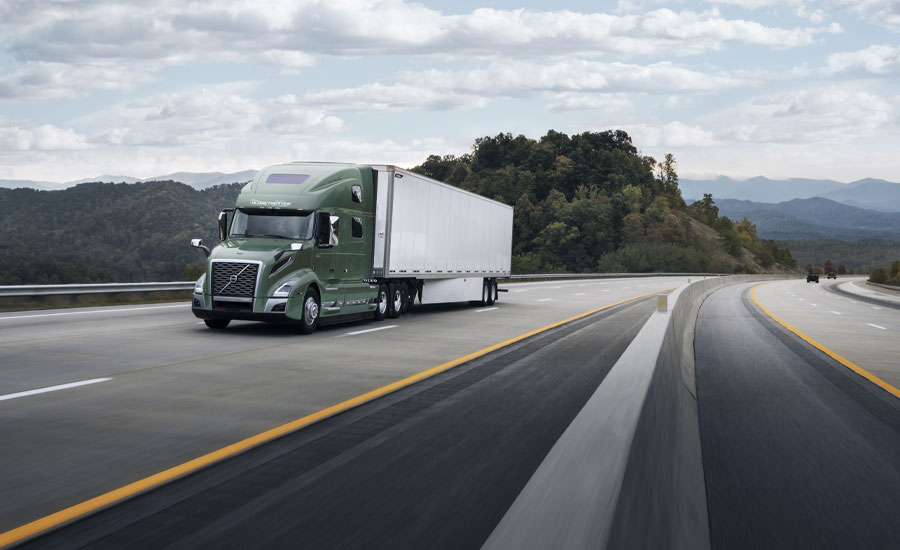
I-Torque comprises the D13 Turbo Compound (TC) engine, the I-Shift with overdrive features, adaptive gear shift strategy, a new map-based version of the predictive cruise control Volvo I-See, and rear axle ratios as low as 2.15.
The overall functionality of the I-Torque configuration is that it uses Volvo Trucks’s 13-speed I-Shift feature with crawler gear, and combines the fuel efficiency advantages of direct drive with the performance and flexibility of overdrive, the company says. By incorporating I-See, low rear axle ratios and load sensing software — at highway speeds, the truck’s system will select either direct drive or overdrive to maximize fuel efficiency without compromising on performance or productivity, it notes. I-Shift together with the new version of the I-See technology, which employs real-time map-based data and GPS positioning, manages speed and gear-shifting in the most fuel-efficient way on any route or terrain and generates up to an additional 1% in fuel savings, it adds.
Lion Electric
Lion Electric this year announced that it teamed up with Transit Truck Bodies for the launch of a new, lightweight, aerodynamic, 100% electric vehicle for medium- and heavy-duty last-mile delivery.
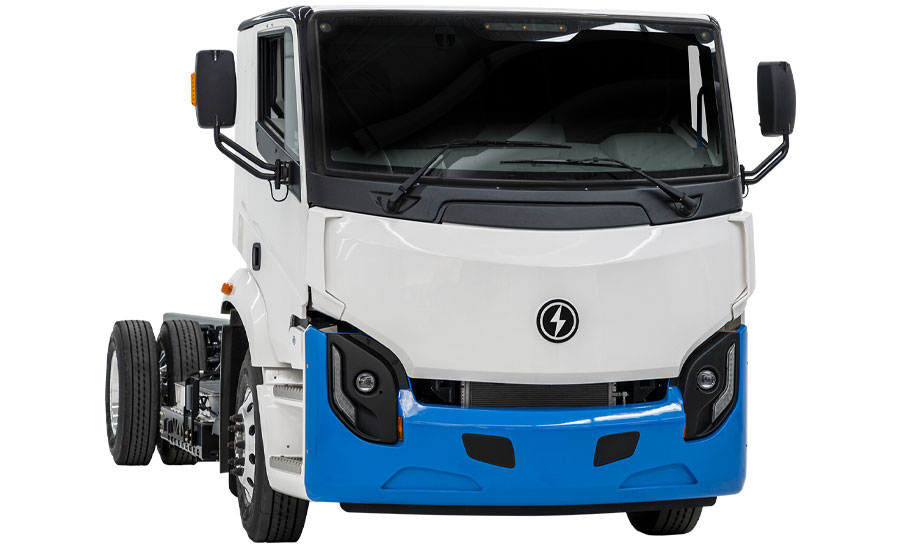
The zero-emission vehicle, designed by Transit, was built on a Lion6 chassis, featuring an e-Classik box — which is about 40% less than the standard model and has been specifically adapted to urban roads. Lion’s all-electric class 6 and class 8 commercial trucks offer charging capacity up to 252 kilowatt-hours, safe lithium-ion batteries and motor power of up to 350 kilowatts and 3,500 Newton-meters of torque. The Lion6 has a cabin length of 79-inches and height of 105 inches, has a powertrain with a top speed of 65 miles per hour and a range of up to 200 miles.
BYD
Earlier this year, BYD announced that buyers of its line of battery-electric trucks now are eligible for funds through the California Air Resources Board (CARB) Hybrid and Zero-Emission Truck and Bus Voucher Incentive Program. Buyers of BYD’s Class 6 models 6F and 6R are eligible for $85,000 while purchasers of Class 8 models 8R and 8TT are eligible for $120,000, it says. Voucher amounts can be increased by an additional 10% if the trucks are domiciled in a disadvantaged community, it adds. The chassis of any vehicle receiving the voucher must be titled and licensed in California and the vehicle must be registered in the state.
Looking for a reprint of this article?
From high-res PDFs to custom plaques, order your copy today!



